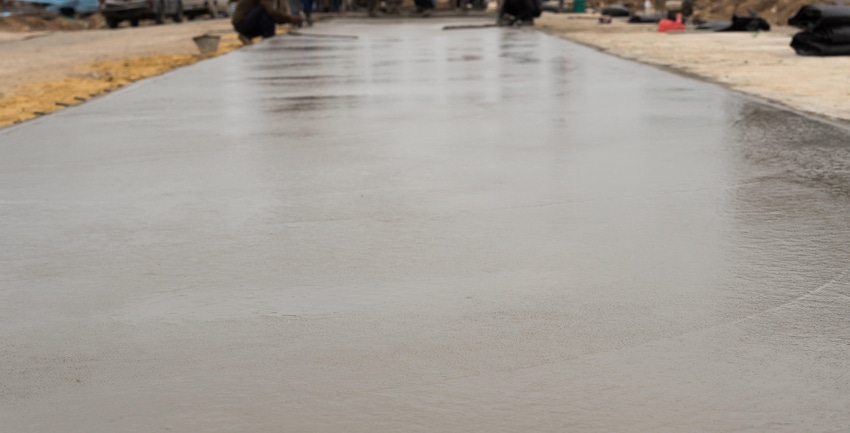The prep work is just as important as stamping and sealing the concrete. Two experts explain all the details and problems to watch out for.

Demand for stamped concrete in residential, commercial and civil applications is booming, and the techniques can expand your concrete business, according to two stamped concrete experts from Patterned Concrete of Cincinnati. But the concrete and site must be prepared properly for a successful project.
Paul Schneider, who has worked with stamped concrete for decades, and his son Kris presented an extensive overview at the World of Concrete recently about preparing a project and stamping the concrete, as well as the problems that can plague projects. Paul is the owner of Patterned Concrete; his son is the firm’s marketing and sales director.
There are many applications for stamped concrete, the presenters said. Commercial applications include sidewalks, way finder paths, break areas, patios, and flooring and paving. Residential projects favor patios, sidewalks, pool decks and driveways. Stamped concrete also is used for streetscapes, parks and sidewalks in civil applications.
Paul Schneider said the concrete mix design is a balance of placeability, strength and durability that includes:
Low water/cement ratio (0.4 to 0.5).
Minimal but workable slump (less than 5)
Well-graded aggregate (maximum size of less than one-third of the slab’s thickness for less shrinkage).
“Fatty” paste.
Common additives, he said, are:
Air entrainment to aid in preventing the concrete from failing in freeze-thaw climates. Includes up to 6% exterior concrete in colder climates.
Water reducer to shrink the water requirement by up to 25%.
Pozzolans-concrete alternatives like fly ash, to improve flexibility and slow set time, and slag, to lighten the concrete’s color.
Retarders to help stretch “your capabilities.”
Accelerators to create equal sets.
Chloride accelerators to mottle and darken the color (but they can increase reinforcement corrosion).
Non-chloride accelerators that do not change the concrete’s color and promote corrosion resistance. These are ideal for stamped and decorative projects.
There are multiple types of finishing aids serving various purposes. Colloidal silica improves workability in hot, dry and windy weather, aids in application of hardeners and does not impact the W/C ratio. Also, naphthalenesulfonic acid improves the color hardener and stamping applications and Confilm (now called MasterKure ER 50) acts as a surface evaporation retarder.
Coloring the slab Paul Schneider said contractors can use integral color or color hardener, adding that his company uses both products. He said that color hardener provides a richer color, although only one-eighth inch to one-quarter inch of the surface has color. It also provides a consistent coat, can be mottled with different colors to create a marble look and decreases the porosity of the finished concrete.
Integral color is not as labor intensive and increases the crew’s productivity, and the cement can be mottled with hardener to create a marble appearance. But the overall color isn’t as vibrant, and there are potential adverse reactions with some admixtures.
Both presenters said that contractors need to be careful about color consistency and recommended having the color mixed into the concrete at the batch plant and finishing the project in a “consistent manner.” For example, if you put a blanket over the first pour because the temperature outside is less than 30 degrees, you need to put a blanket over the second pour, too, even if the temperature rises to above 30 degrees, Paul Schneider said.
Color hardening
Color hardeners are applied after the initial bull floating operation, and contractors need to wait for the concrete to bleed the water to the surface before continuing work. Then throw the hardener “like throwing dice,” Paul Schneider said. Let the color absorb the water before starting to work the hardener into the surface using a wood bull float. Then do the “finger test. Put your fingers on the concrete. If it’s ready, it will look like it has hardened out.”
Proper coloring, the presenter said, requires multiple passes; the first pass achieves 60% to 70% of the coverage and the second pass covers the remainder. Lighter colors require more product than darker colors to achieve the appropriate coverage.
Paul Schneider said, “Use a supplier who will stand behind their product,” and follow the manufacturer’s recommendations to determine the coverage rate.
Prices for integral colors vary based on the color loading percentage—the higher the percentage, the greater the cost.
Release agents
There are two main types of release agents: dry powder and liquid. Release agents provide a bond break to help keep the stamps from sticking to the concrete surface. Powdered release also provides a secondary “antiquing” color.
Dry powder can be spread by hand or the bucket/mason’s brush technique, which the Schneiders recommended. Only apply enough release to change the color, though. They also suggested wearing a respirator because the process creates dust.
Liquid releases are applied with a pump-up spray can and provide “instant gratification—you see what the stamped surface looks like immediately,” Paul Schneider said. But beware: When you pick up the stamps you could have an orange peeling effect.
The presenters discussed two methods to achieve antiquing:
Spray the slab with liquid release and stamp; then saw cut, detail and clean the slab. Mix the antiquing powder to the manufacturer’s recommendations and allow the surface to dry before sealing. (But don’t use a blower to speed up the drying process.)
Spray the slab with a release and then stamp. After stamping, mix the antiquing release into the liquid release. Flood the surface with the mixture.
The Schneiders also carefully explained their techniques for stamping concrete. To read about those, click here.
About the Author(s)
You May Also Like




